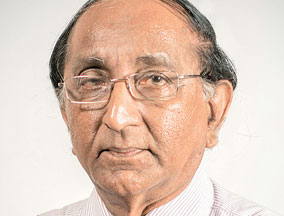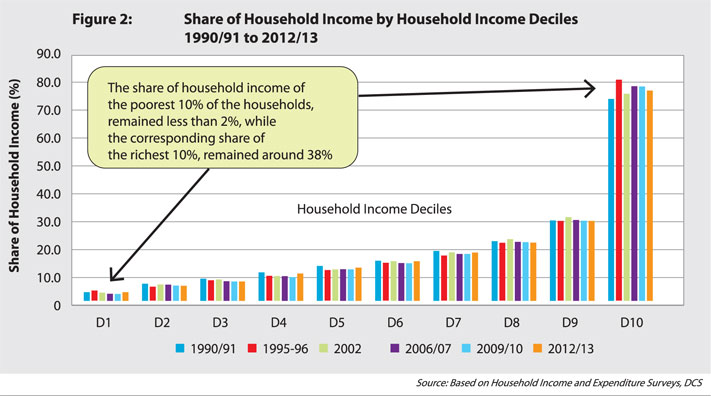Income inequality could harm economic growth
Services and industrial sectors growing faster than
agriculture:
 By Wimal Nanayakkara By Wimal Nanayakkara
Although inequality in society is not a new phenomenon, if inequality
persists, without proper attention, it could affect the overall economic
growth of the country and the efforts to reduce poverty.
Reducing the incidence of poverty by half and eradicating extreme
poverty, are two of the important targets expected to be achieved by
2030, under the Sustainable Development Goals (SDGs).
Although many countries including Sri Lanka managed to reduce poverty
during the past two to three decades, inequality is still a major
concern. Inequality in income represents only one dimension of
inequality.
Data on access to education and health, ownership of assets, access
to services such as water, electricity, improved sanitation, etc., can
also reveal inequality to be quite high, even in countries in which
income inequality is not particularly high.
As such, due attention should also turn to the disparities in
education, health, nutrition, access to various services, as well, to
identify possible inequalities, which may exist, so that appropriate
action could be taken to minimize such gaps. In this article, the
discussion is limited to only poverty and income inequality in Sri
Lanka.
Extreme poverty
Free education and health services, and various social protection
programmes, implemented by successive governments, for over six decades
have helped Sri Lanka achieve most important MDG targets, related to
education, health, poverty and access to services.
Source: Based on Household Income and Expenditure Surveys (DCS) and
World Bank 'Povcalnet'
However, there are regional variations, which need the attention of
planners and policy makers. The incidence of poverty in the country,
declined steadily from 26.1% in 1990/91 to 6.7% in 2012/13 (Figure 1),
based on the national poverty line.
 The proportion of population living below the global poverty line
$1.25 a day [2005 Purchasing Power Parity (PPP)], which was used to
measure extreme poverty, until 2015, fell from 15.0% in 1990/91 to 3.5%
in 2012/13. The proportion of population living below the global poverty line
$1.25 a day [2005 Purchasing Power Parity (PPP)], which was used to
measure extreme poverty, until 2015, fell from 15.0% in 1990/91 to 3.5%
in 2012/13.
The other global poverty line, which was also used for international
comparisons, was $2.00 a day. The proportion of the population earning
below $2.00 a day, declined from 49.5% in 1990/91 to 19.6% in 2012/13.
However, the gap between these two poverty lines ($1.25 a day and $2.00
a day) is still high, indicating that a considerably high proportion of
the population is just above the extreme poverty line and, therefore,
could slip back to extreme poverty due to economic shocks, such as
increases in prices of basic essentials, loss of livelihood due to
natural disasters or any other reason.
Although the incidence of poverty is low in Sri Lanka, bringing
extreme poverty to zero level, will be a challenging task. To achieve
this, proper identification and precise targeting of people in extreme
poverty, for social protection programmes is essential.
An in-depth analysis of the data of Household Income and Expenditure
Surveys (HIES) conducted by the Department of Census and Statistics (DCS),
shows that the poorest people in Sri Lanka are those living in
households headed by 'agricultural or non-agricultural labourers',
'skilled agricultural workers' and 'people who are disabled or too old
to work'.
As such, further reduction of poverty or eradicating extreme poverty,
will depend on precise targeting of most vulnerable groups and on
effective strategies to create suitable employment opportunities, in all
regions. Analysis of HIES data, show that some of the most deserving
families are not covered in social protection programmes such as 'Samurdhi',
while those not deserving, continue to receive such benefits.
The bulk of the poor are largely rural-based and the majority rely on
agriculture for their livelihood. Although the agricultural sector shows
a relatively slow growth, compared to industrial and service sectors and
the contribution to GDP is only around 10%, it does not mean that the
agricultural production is declining. It simply means that the service
and industrial sectors are growing at a faster rate.
Agriculture sector
It is important to note that around 30.0% of the employed population
are still engaged in agriculture and are producing food for 20.3 million
people. This fact should not be ignored when developing strategies to
reduce poverty and eradicate extreme poverty.
 Pro-poor economic transition cannot be achieved by abandoning the
agricultural sector. Instead, sufficient attention needs to be given to:
increase agricultural productivity by improving extension services,
introducing new technology and farming techniques, which helps farmers;
provide advice and assistance to setup agro-based industries, which
could create new employment opportunities for rural youth; continuously
improve rural infrastructure and marketing facilities, so that the
farmers could easily find markets for their produce. Pro-poor economic transition cannot be achieved by abandoning the
agricultural sector. Instead, sufficient attention needs to be given to:
increase agricultural productivity by improving extension services,
introducing new technology and farming techniques, which helps farmers;
provide advice and assistance to setup agro-based industries, which
could create new employment opportunities for rural youth; continuously
improve rural infrastructure and marketing facilities, so that the
farmers could easily find markets for their produce.
Promoting sustainable agriculture is the key to achieve the SDG-2 -
'End hunger, achieve food security and improved nutrition and promote
sustainable agriculture'.
High and growing inequality makes inclusive growth more difficult.
Beyond a certain threshold, inequality could harm growth and poverty
reduction. Although there was no specific goal on inequality, under MDGs,
for SDGs, Goal 10: 'Reduce Inequality within and among countries', is
specifically dedicated to inequality.
The main target under this goal says, "By 2030, progressively achieve
and sustain economic growth of the bottom 40% of the population at a
rate higher than the national average".
Source: Based on Household Income and Expenditure Surveys, DCS
This is not an easy task, as income inequality in Sri Lanka is high
and has remained more or less unchanged, for more than three decades.
While the share of household income of the poorest decile has remained
less than 2%, the corresponding share of the richest decile has remained
around 38% throughout from 1990/91 to 2012/13 (Figure 2).
Even in the ninth household income decile, the share of total
household income, is only 15%, while the share of the richest decile, is
more than twice the share of the ninth decile, indicating that it is the
people in the richest 10% of the households, who hold the major share of
household income.
This pattern has remained unchanged from 1990/91 to 2012/13.The
Ginico efficient for household income, which is one of the key measures
of inequality, increased from 0.43 in 1990/91 to 0.49 in 2006/07 and
remained unchanged at around 0.48, thereafter.
The increase in income inequality does not necessarily mean that the
poor are getting poorer and rich are getting richer. It is rather, the
rich get richer, at a faster rate. As such, as recommended by SDG
targets, it would be necessary to adopt suitable policies, to "ensure
progressive achievement and sustained income growth of the bottom 40% of
the population at a rate higher than the national average".
Options
In addition to what has been already recommended above, it is
necessary to create more decent employment opportunities for youth in
all regions, especially for rural youth and women in general, to reduce
income inequality. Labour Force Participation Rate for women in Sri
Lanka is extremely low (around 35%).
This could be mainly due to non-availability of suitable employment
opportunities close to their homes. Availability of such employment
opportunities, that do not need long distance travel, makes it easier
for them to balance child-care responsibilities with work.
Flexible working hours and/or facilitating working from home may be
attractive to women. This may help in increasing the labour force
participation of women, which will increase their family incomes.
At least one family member at a household being employed with a
decent, regular income increases the chance of improving the living
conditions of the entire family.
Many people with low skills in particular, remain trapped in
precarious jobs, often in informal and unregulated economic activities.
Even full-time employment in such jobs tends to be insufficient to lift
households out of poverty. As such, well designed active labour market
policies aimed at improving skills to meet the demand to reduce the
present skills mismatch is important. Thus, creating accessible,
productive and rewarding jobs in all regions, without any
discrimination, is the key to minimize poverty and reduce inequality.
The writer is a Senior Visiting Fellow at the Institute of Policy
Studies of Sri Lanka (IPS). |

